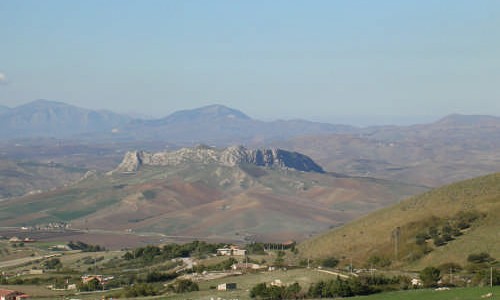The Last Italian Emirate March 13, 2017
Author: Beach Combing | in : Medieval , trackbackFrom 1060-1091 Christian warriors, ‘Normans’, defeated the Islamic powers in Sicily and returned the island to the Catholic flock. For most historians this is the end of Arab civilization there, with the exception of some starbursts of Arab architecture and Arab art through the next two to three generations. However, there is one final Arab chapter, lost in the shadows. Sicilian Muslims, who had suffered abuse from crown and Italian settlers in the fifty years before, including veritable pogroms in eastern Sicily, rose to retake Sicily in 1189. They lacked the power, to do so, of course, but they were able to secure mountain enclaves and in their desperation refused all negotiations with the Christian authorities. On the death of Henry IV in 1197 the island exploded into an all out civil war. This was fought essentially between ‘German’ and ‘Papal’ factions in a pattern wearily repeated though the peninsula. But in the rest of Italy there was not a concurrent Muslim rebellion. The emirate now took on a more convincing form and absorbed several important settlements in the western interior including Corleone and Entella (in the photograph). Indeed, with courage and brio these rebellious Sicilian Arabs managed to keep their emirate going to 1246, though by the end it became again some isolated pockets of mountain. If you had been born in the right part of the emirate in 1189, there was a very reasonable chance that you would have died thirty or forty or fifty years later under a Muslim ruler.
From 1200 onwards raiding bands roved across the island and attacked Christian villages and strongholds often taking hostages: they particularly enjoyed snatching Christian priests. Their most notorious leader Ibn Abbad was said to have had 30,000 warriors under him, an impressive number for any European state at this date. He also, before his death at Christian hands in 1222 (he was treacherously drowned), minted coins for the faithful. His daughter, meanwhile, had her revenge from the emirate’s greatest stronghold, Entella. She had Frederick II send 300 knights so she could hand over the keys to her father’s fortress. Instead she had them murdered at the gate and then took her own life. The final mountain peaks of the emirate struggled on for almost a generation after her suicide, but Frederick II had started ethnic cleansing in the 1220s. Muslims who returned under Christian rule and refused to convert were sent to live in mainland Italy in the Apulian settlement of Lucera (another post, another day). Muslim Sicily was not just conquered, by 1246 it had been obliterated.
Anything else on the last Sicilian Emirate: drbeachcombing At yahoo DOT com
LTM sends in 30 Mar 2017 another Forgotten Kingdom from Sicily, see Wikipedia:
Piana degli Albanesi was founded in the late fifteenth century by a large group of Albanian refugees coming from the Balkans during the conquest of the latter by the Ottoman Empire. The exodus began after the defeat of the Byzantine Empire and the death of Skanderbeg, who successfully fought for the freedom of their people for more than two decades. The village foundation was officially sanctioned on August 30, 1488, based on an official request sent in 1486–1487 to Cardinal Juan de Borja, archbishop of the Archdiocese of Monreale, demanding the right to remain in the lands of Mercu and Aydingli, located in the mountains in the province of Palermo. In 1482–85, after several attacks from the Ottoman Empire, the Christian Albanians were forced to the Adriatic coast where they hired ships from Republic of Venice, escaped by sailing and managed to reach the island of Sicily. They apparently were housed in temporary camps somewhere near Palermo until about 1486 or 1487, when they were granted land known initially as the “Plain of the Archbishop”, inland areas of Sicily in the mountains above the city of Palermo. Signed the “capitulation” in Albanian and Italian, which were also recognized with followed by the Brief of Pope Sixtus IV, the official concession of land was granted to the settlers in 1488, followed by the construction of what became the largest Albanian center of the island and primarily, religious buildings. King John II of Spain and Sicily allowed the original refugees to occupy the present place and to preserve their Orthodox Christian rite. These Albanian refugees were at the time referred to by the surrounding population as “Greeks” on account of their Orthodox faith and the settlement became known as Piana dei Greci. For example, in 1673, the local priest Domenico Mamola in a note written in Greek refers to the settlement as Piana dei Greci. In 1941 during Mussolini’s invasion of Greece, the name was changed to Piana degli Albanesi so as to gain the locals support for the fascist regime’s imperialist intentions toward Albania. The name Piana degli Albanesi or Plain of the Albanians is a literal translation of the local Arbëreshë name: Hora e Arbëreshëvet.



